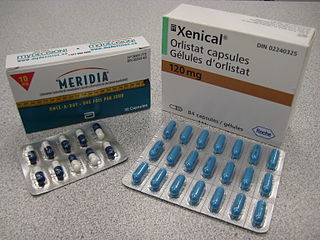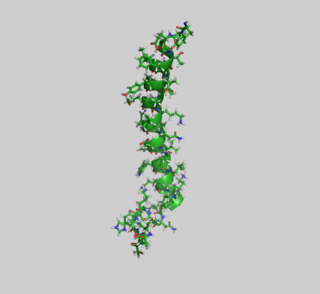
Anti-obesity medication or weight loss medications are pharmacological agents that reduce or control excess body fat. These medications alter one of the fundamental processes of the human body, weight regulation, by reducing appetite and consequently energy intake, increasing energy expenditure, redirecting nutrients from adipose to lean tissue, or interfering with the absorption of calories.

Incretins are a group of metabolic hormones that stimulate a decrease in blood glucose levels. Incretins are released after eating and augment the secretion of insulin released from pancreatic beta cells of the islets of Langerhans by a blood-glucose–dependent mechanism.

Glucose-dependent insulinotropic polypeptide, abbreviated as GIP, is an inhibiting hormone of the secretin family of hormones. While it is a weak inhibitor of gastric acid secretion, its main role, being an incretin, is to stimulate insulin secretion.
Oxyntomodulin is a naturally occurring 37-amino acid peptide hormone found in the colon, produced by the oxyntic (fundic) cells of the oxyntic (fundic) mucosa. It has been found to suppress appetite.

Glucagon-like peptide-1 (GLP-1) is a 30- or 31-amino-acid-long peptide hormone deriving from the tissue-specific posttranslational processing of the proglucagon peptide. It is produced and secreted by intestinal enteroendocrine L-cells and certain neurons within the nucleus of the solitary tract in the brainstem upon food consumption. The initial product GLP-1 (1–37) is susceptible to amidation and proteolytic cleavage, which gives rise to the two truncated and equipotent biologically active forms, GLP-1 (7–36) amide and GLP-1 (7–37). Active GLP-1 protein secondary structure includes two α-helices from amino acid position 13–20 and 24–35 separated by a linker region.

The glucagon-like peptide-1 receptor (GLP1R) is a G protein-coupled receptor (GPCR) found on beta cells of the pancreas and on neurons of the brain. It is involved in the control of blood sugar level by enhancing insulin secretion. In humans it is synthesised by the gene GLP1R, which is present on chromosome 6. It is a member of the glucagon receptor family of GPCRs. GLP1R is composed of two domains, one extracellular (ECD) that binds the C-terminal helix of GLP-1, and one transmembrane (TMD) domain that binds the N-terminal region of GLP-1. In the TMD domain there is a fulcrum of polar residues that regulates the biased signaling of the receptor while the transmembrane helical boundaries and extracellular surface are a trigger for biased agonism.

The gastric inhibitory polypeptide receptor (GIP-R), also known as the glucose-dependent insulinotropic polypeptide receptor, is a protein that in humans is encoded by the GIPR gene.

Free fatty acid receptor 2 (FFAR2), also termed G-protein coupled receptor 43 (GPR43), is a rhodopsin-like G-protein coupled receptor. It is coded by the FFAR2 gene. In humans, the FFAR2 gene is located on the long arm of chromosome 19 at position 13.12. Like other GPCRs, FFAR2s reside on the surface membrane of cells and when bond to one of their activating ligands regulate the function of their parent cells. FFAR2 is a member of a small family of structurally and functionally related GPRs termed free fatty acid receptors (FFARs). This family includes three other receptors which, like FFAR2, are activated by certain fatty acids: FFAR1, FFAR3 (GPR41), and FFAR4 (GPR120). FFAR2 and FFAR3 are activated by short-chain fatty acids whereas FFAR1 and FFAR4 are activated by long-chain fatty acids.
Glucagon-like peptide-1 (GLP-1) receptor agonists, also known as GLP-1 analogs, are a class of drugs that reduce blood sugar and energy intake by activating the GLP-1 receptor. They mimic the actions of the endogenous incretin hormone GLP-1 that is released by the gut after eating.
A duodenal-jejunal bypass liner, commonly called an EndoBarrier, is an implantable medical device in the form of a thin flexible 60 cm-long tube that creates a physical barrier between ingested food and the duodenum/proximal jejunum. The duodenal-jejunal bypass liner prevents the interaction of food with enzymes and hormones in the proximal intestine to treat type 2 diabetes and obesity. The duodenal-jejunal bypass liner is delivered endoscopically and has been tested on the morbidly obese as well as obese patients with a BMI less than 40, particularly those with difficult-to-manage type 2 diabetes. Despite a handful of serious adverse events such as gastrointestinal bleeding, abdominal pain, and device migration — all resolved with device removal — initial clinical trials have produced promising results in the treatment's ability to improve weight loss and glucose homeostasis outcomes.

Tirzepatide, sold under the brand name Mounjaro among others, is an antidiabetic medication used for the treatment of type 2 diabetes and for weight loss. Tirzepatide is administered through subcutaneous injection.
Cagrilintide is a long-acting analogue of amylin. It is being tested to treat obesity and type 2 diabetes by itself and in combination with semaglutide as cagrilintide/semaglutide.
Dual amylin and calcitonin receptor agonists (DACRAs) are a class of drugs that act as agonists at the amylin receptor and calcitonin receptor that are under development as therapies for obesity and type 2 diabetes. Examples are cagrilintide and the KBP family derived from salmon calcitonin, including KBP‐042, KBP-066A, KBP-089, and KBP-336.
Ecnoglutide (XW003) is a GLP-1 agonist being developed for the treatment of obesity and type 2 diabetes. In preclinical trials, "Ecnoglutide showed a favorable potency, pharmacokinetic, and tolerability profile, as well as a simplified manufacturing process" compared to other GLP-1 agonists.
GSBR-1290 is a small-molecule GLP-1 agonist developed by Structure Therapeutics. It is delivered orally and is in a Phase II trial as of 2023.
Glucagon receptor agonists are a class of drugs under development for the treatment of obesity, non-alcoholic fatty liver disease, and congenital hyperinsulinism.
GLP1 poly-agonist peptides are a class of drugs that activate multiple peptide hormone receptors including the glucagon-like peptide-1 (GLP-1) receptor. These drugs are developed for the same indications as GLP-1 receptor agonists—especially obesity, type 2 diabetes, and non-alcoholic fatty liver disease. They are expected to provide superior efficacy with fewer adverse effects compared to GLP-1 mono-agonists, which are dose-limited by gastrointestinal disturbances. The effectiveness of multi-receptor agonists could possibly equal or exceed that of bariatric surgery. The first such drug to receive approval is tirzepatide, a dual agonist of GLP-1 and GIP receptors.
HRS9531 is an experimental GLP-1 and GIPR dual agonist developed by Jiangsu Hengrui.
Survodutide is an experimental peptide that works as a dual glucagon/GLP-1 receptor agonist. Unlike other dual GLP-1/glucagon dual agonists, it is an glucagon analog rather than an analog of oxyntomodulin. It is developed by Boehringer Ingelheim as a weight loss drug.
GLY-200 is an experimental drug that acts as a "polymeric mucin binding duodenal exclusion therapy"; it is developed by Glyscend Therapeutics for type 2 diabetes and obesity. It is intended to reversibly mimic the effects of gastric bypass without the need for surgery. The drug is not absorbed into the body from the gut and has been tested as monotherapy and with metformin.





